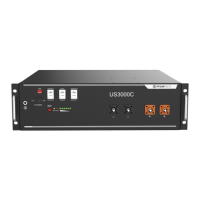
Do you have a question about the Pylontech US3000C and is the answer not in the manual?
| Battery Type | Lithium Iron Phosphate (LiFePO4) |
|---|---|
| Nominal Voltage | 48V |
| Capacity | 74Ah |
| Discharge Current (Recommended) | 37A |
| Discharge Current (Maximum) | 74A |
| Communication | CAN, RS485 |
| Cycle Life | 6000 Cycles @ 25°C |
| Operating Temperature | -10°C to 50°C |
| Scalability | Up to 16 units in parallel |
| Certification | CE, UN38.3 |
Essential safety instructions and warnings for handling the battery, covering general precautions and storage.
Guidelines and warnings to follow before connecting the battery, including checking for damage and ensuring correct wiring.
Precautions and prohibitions during the operation and use of the battery, including moving, repair, and fire safety.
Detailed overview of the US3000C battery's key features, including soft-start, dual protection, and communication capabilities.
Comprehensive technical specifications including dimensions, weight, voltage, capacity, operating conditions, and certifications.
Explanation of the battery module's interface, including power switch, status LEDs, and port functions for operation.
Detailed mapping of pins for the RJ45 port, specifying functions for A/CAN, B/RS485, and communication protocols.
Description of the LED indicators on the battery module and their meanings for different operational states and errors.
Overview of the Battery Management System (BMS) functions, including protection, alarm, and monitoring capabilities.
Visual representation of how the battery module connects within a typical solar or energy storage system.
List of essential tools recommended for the installation and maintenance of the battery system.
Recommended personal protective equipment (PPE) such as gloves, goggles, and shoes for safe handling of the battery.
Details of the items included in the battery module and external cable kits for installation.
Criteria for selecting a suitable installation site, including environmental conditions and spatial considerations.
Instructions for proper grounding of the battery module to ensure safety and system integrity.
Steps for mounting battery modules within a cabinet or rack system, including connecting cables.
Instructions for installing battery modules using mounting brackets, including assembly and securing steps.
Step-by-step guide for powering up the battery system, including master/slave configuration and LED indicators.
Instructions for safely shutting down the battery system, including turning off external power and switches.
Guide for connecting multiple battery groups using RS485 communication, including dip switch settings and master/slave roles.
Guide for connecting multiple battery groups using CAN communication via an LV-HUB, including dip switch settings.
Steps to diagnose issues based on battery status indicators like power, LEDs, and charging/discharging capability.
Detailed solutions for common problems such as battery not turning on, red LED indicators, and temperature-related faults.
Procedures to follow in case of electrolyte leakage, including first aid for inhalation, skin, and eye contact.
Guidelines for the proper recycling and disposal of battery modules in accordance with regulations.
Recommendations for routine maintenance, including charging frequency, inspection of connections, and environmental checks.